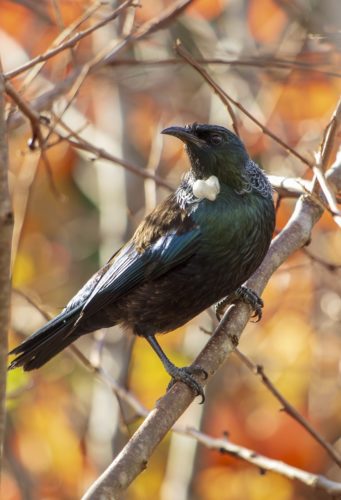 The Tui is one of the most magnificent birds in New Zealand. With their distinctive white puffs underneath these little songsters look similar to a Bellbird. However, Tui can’t be found anywhere else in the world. Their sounds range from melodious tunes to screams, coughs and even grunts. Due to their attractive looks and their unique calls, they are a well-loved sight in gardens and backyards throughout the country.
The Tui is one of the most magnificent birds in New Zealand. With their distinctive white puffs underneath these little songsters look similar to a Bellbird. However, Tui can’t be found anywhere else in the world. Their sounds range from melodious tunes to screams, coughs and even grunts. Due to their attractive looks and their unique calls, they are a well-loved sight in gardens and backyards throughout the country.
The natural habitat of Tui is forests and scrub. However, if presented with delicious nectar, Tui are known to fly up to 10 kilometres daily to feast. They are part of the honeyeater family, hence have quite a sweet tooth and prefer a range of flowers, fruit trees and the honeydew from native trees.
Tui play a vital role in New Zealand’s landscape as they busy themselves pollinating flowering plants and scattering seeds of fruit trees around. If you’d like to attract Tui to your garden, you can do so by planting rich nectar-producing trees and flowers. Keep in mind that each plant flowers at a different time of the year. The more variety you have, the more likely you will get to enjoy Tui all year round.
Favourite natives
The Department of Conservation recommends planting native trees rather than imports to minimise the impact on endemic species. One of the most popular natives for Tui is the Kōwhai. The trees get their name from the bright yellow flowers which appear from mid-winter to spring. Kōwhai makes a perfect tree to plant to attract Tui to your garden. With the right pruning they can be shaped into small to medium-sized plants up to 10 metres tall.
Flax, or Harakeke, is also popular with Tui and can be grown anywhere in New Zealand. The ancient plant species grows beautiful bright red flowers, providing nectar for native birds from spring to summer. While the common flax can reach heights up to 3 meters, the mountain variety is much smaller and makes a perfect addition to your garden.
Cabbage Trees and Mountain Fivefingers are also great choices. Cabbage trees grow up to 20 metres high if not pruned. They prefer wet areas such as swamps and produce lovely scented flowers in early summer followed by nourishing berries for your feathery friends.
The mountain fivefinger is more of an evergreen shrub. It reaches a maximum of 5 meters, growing greenish heavy-scented flowers and black fruits from late spring to early autumn. The only downside is that Possums absolutely thrive on Fivefingers, so extra predator protection is required.
Favourite imports
While some native species such as the Kōwhai are semi-evergreen and will lose their leaves at some point, another favourite of the Tui will give you colour all year round. The Coast Banksia, introduced from neighbouring Australia, is an evergreen with silky yellow flowers looking like candles. The leaves are dark green on the top and silvery underneath, providing a rich contrast to the Tui’s greenish blue feathers. This ornamental tree is fast growing and will easily reach heights of 10 meters if not pruned back regularly, but it will reward you with shelter and flowers from summer to winter, attracting Tui to your garden any season of the year.
Another import and an absolute favourite of the Tui is the Taiwan cherry. Its flowers have a distinctive bell shape and come in all shades of pink. They flower quite early, much sooner than most native trees, and therefore provide an important food source for the Tui when there’s not much else around. Unfortunately, as beautiful as the Taiwan cherry may look, it also tends to seed everywhere and is now considered a weed in many parts of New Zealand.
If you don’t have the space, time or budget to turn your backyard into a Tui paradise, don’t despair. Try growing shrubs and smaller trees such as Flax and Kōwhai in buckets and containers. Putting out a bird-feeder filled with sugar water might not be as effective, but it will also attract the odd Tui to your garden.


